Principles of Nursing: Surgical Care for Ted Williams Case Study
VerifiedAdded on 2022/09/25
|10
|2900
|22
Case Study
AI Summary
This case study focuses on Ted Williams, an 82-year-old male, four days post-operative after a bowel resection and colostomy. The assignment analyzes Ted's health status, including his history of heart failure, type II diabetes, obesity, and gout. The paper applies clinical reasoning techniques to assess the biopsychosocial, spiritual, and cultural impacts of the surgery on Ted and his family. It evaluates his current health information, identifies potential problems such as fever, high blood pressure, and respiratory issues, and proposes five nursing care strategies to address these concerns. The study also suggests appropriate medications for Ted's post-operative recovery, categorized into different drug groups. The analysis highlights the importance of patient assessment, intervention planning, and medication management in providing comprehensive surgical nursing care.

Running head: PRINCIPLES OF NURSING: SURGICAL
1
Principles of Nursing-Surgical
Student’s Name
Institutional Affiliation
1
Principles of Nursing-Surgical
Student’s Name
Institutional Affiliation
Paraphrase This Document
Need a fresh take? Get an instant paraphrase of this document with our AI Paraphraser
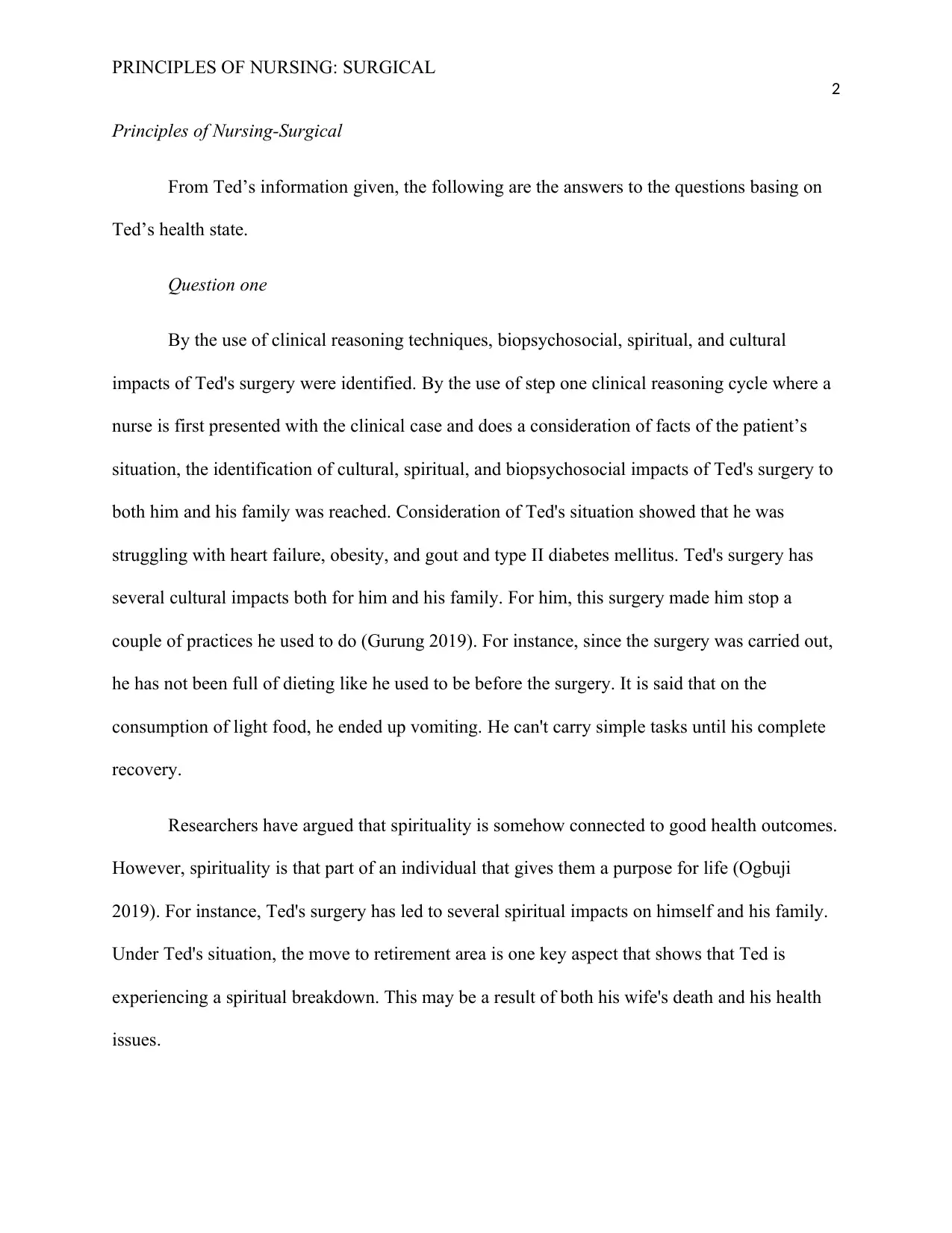
PRINCIPLES OF NURSING: SURGICAL
2
Principles of Nursing-Surgical
From Ted’s information given, the following are the answers to the questions basing on
Ted’s health state.
Question one
By the use of clinical reasoning techniques, biopsychosocial, spiritual, and cultural
impacts of Ted's surgery were identified. By the use of step one clinical reasoning cycle where a
nurse is first presented with the clinical case and does a consideration of facts of the patient’s
situation, the identification of cultural, spiritual, and biopsychosocial impacts of Ted's surgery to
both him and his family was reached. Consideration of Ted's situation showed that he was
struggling with heart failure, obesity, and gout and type II diabetes mellitus. Ted's surgery has
several cultural impacts both for him and his family. For him, this surgery made him stop a
couple of practices he used to do (Gurung 2019). For instance, since the surgery was carried out,
he has not been full of dieting like he used to be before the surgery. It is said that on the
consumption of light food, he ended up vomiting. He can't carry simple tasks until his complete
recovery.
Researchers have argued that spirituality is somehow connected to good health outcomes.
However, spirituality is that part of an individual that gives them a purpose for life (Ogbuji
2019). For instance, Ted's surgery has led to several spiritual impacts on himself and his family.
Under Ted's situation, the move to retirement area is one key aspect that shows that Ted is
experiencing a spiritual breakdown. This may be a result of both his wife's death and his health
issues.
2
Principles of Nursing-Surgical
From Ted’s information given, the following are the answers to the questions basing on
Ted’s health state.
Question one
By the use of clinical reasoning techniques, biopsychosocial, spiritual, and cultural
impacts of Ted's surgery were identified. By the use of step one clinical reasoning cycle where a
nurse is first presented with the clinical case and does a consideration of facts of the patient’s
situation, the identification of cultural, spiritual, and biopsychosocial impacts of Ted's surgery to
both him and his family was reached. Consideration of Ted's situation showed that he was
struggling with heart failure, obesity, and gout and type II diabetes mellitus. Ted's surgery has
several cultural impacts both for him and his family. For him, this surgery made him stop a
couple of practices he used to do (Gurung 2019). For instance, since the surgery was carried out,
he has not been full of dieting like he used to be before the surgery. It is said that on the
consumption of light food, he ended up vomiting. He can't carry simple tasks until his complete
recovery.
Researchers have argued that spirituality is somehow connected to good health outcomes.
However, spirituality is that part of an individual that gives them a purpose for life (Ogbuji
2019). For instance, Ted's surgery has led to several spiritual impacts on himself and his family.
Under Ted's situation, the move to retirement area is one key aspect that shows that Ted is
experiencing a spiritual breakdown. This may be a result of both his wife's death and his health
issues.
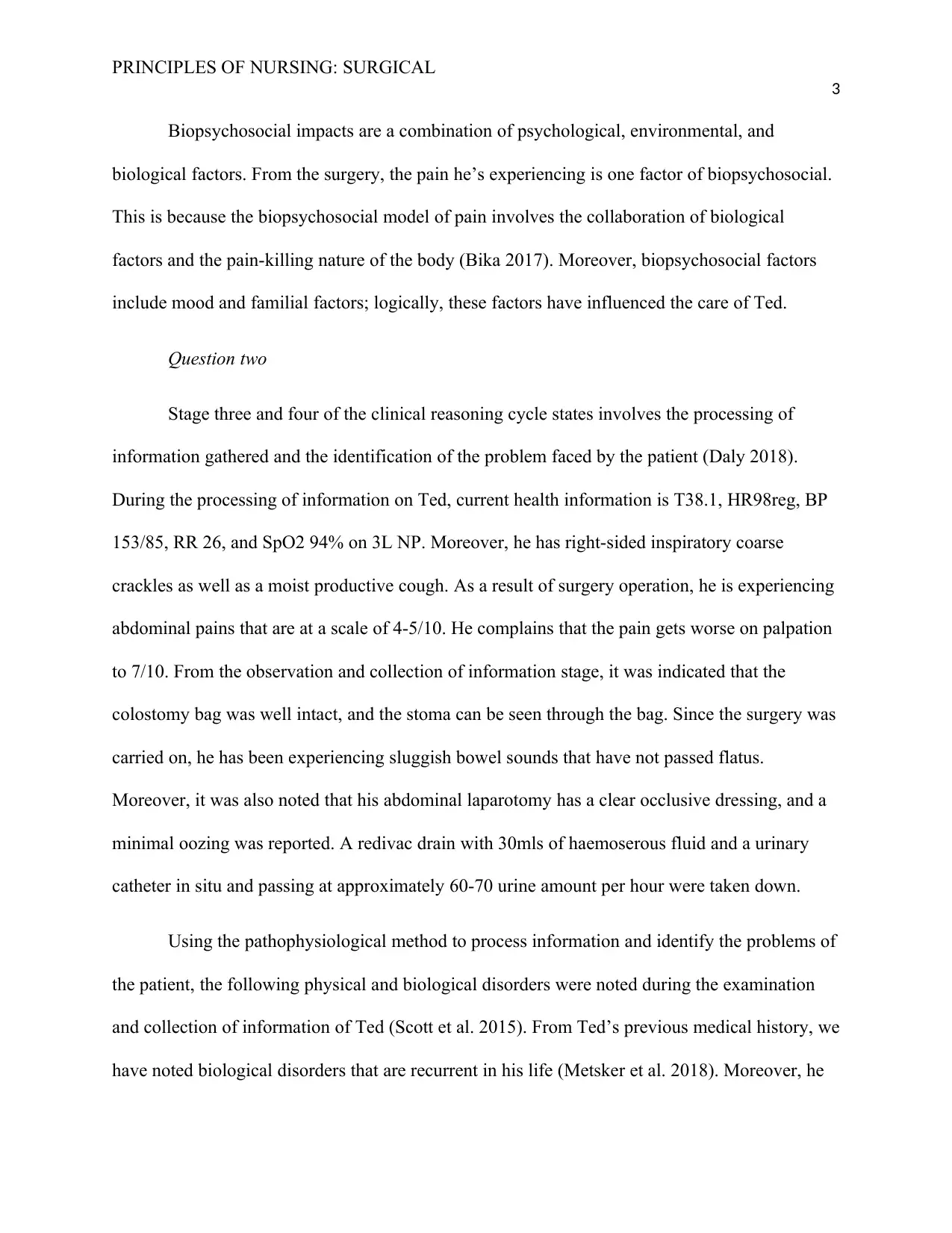
PRINCIPLES OF NURSING: SURGICAL
3
Biopsychosocial impacts are a combination of psychological, environmental, and
biological factors. From the surgery, the pain he’s experiencing is one factor of biopsychosocial.
This is because the biopsychosocial model of pain involves the collaboration of biological
factors and the pain-killing nature of the body (Bika 2017). Moreover, biopsychosocial factors
include mood and familial factors; logically, these factors have influenced the care of Ted.
Question two
Stage three and four of the clinical reasoning cycle states involves the processing of
information gathered and the identification of the problem faced by the patient (Daly 2018).
During the processing of information on Ted, current health information is T38.1, HR98reg, BP
153/85, RR 26, and SpO2 94% on 3L NP. Moreover, he has right-sided inspiratory coarse
crackles as well as a moist productive cough. As a result of surgery operation, he is experiencing
abdominal pains that are at a scale of 4-5/10. He complains that the pain gets worse on palpation
to 7/10. From the observation and collection of information stage, it was indicated that the
colostomy bag was well intact, and the stoma can be seen through the bag. Since the surgery was
carried on, he has been experiencing sluggish bowel sounds that have not passed flatus.
Moreover, it was also noted that his abdominal laparotomy has a clear occlusive dressing, and a
minimal oozing was reported. A redivac drain with 30mls of haemoserous fluid and a urinary
catheter in situ and passing at approximately 60-70 urine amount per hour were taken down.
Using the pathophysiological method to process information and identify the problems of
the patient, the following physical and biological disorders were noted during the examination
and collection of information of Ted (Scott et al. 2015). From Ted’s previous medical history, we
have noted biological disorders that are recurrent in his life (Metsker et al. 2018). Moreover, he
3
Biopsychosocial impacts are a combination of psychological, environmental, and
biological factors. From the surgery, the pain he’s experiencing is one factor of biopsychosocial.
This is because the biopsychosocial model of pain involves the collaboration of biological
factors and the pain-killing nature of the body (Bika 2017). Moreover, biopsychosocial factors
include mood and familial factors; logically, these factors have influenced the care of Ted.
Question two
Stage three and four of the clinical reasoning cycle states involves the processing of
information gathered and the identification of the problem faced by the patient (Daly 2018).
During the processing of information on Ted, current health information is T38.1, HR98reg, BP
153/85, RR 26, and SpO2 94% on 3L NP. Moreover, he has right-sided inspiratory coarse
crackles as well as a moist productive cough. As a result of surgery operation, he is experiencing
abdominal pains that are at a scale of 4-5/10. He complains that the pain gets worse on palpation
to 7/10. From the observation and collection of information stage, it was indicated that the
colostomy bag was well intact, and the stoma can be seen through the bag. Since the surgery was
carried on, he has been experiencing sluggish bowel sounds that have not passed flatus.
Moreover, it was also noted that his abdominal laparotomy has a clear occlusive dressing, and a
minimal oozing was reported. A redivac drain with 30mls of haemoserous fluid and a urinary
catheter in situ and passing at approximately 60-70 urine amount per hour were taken down.
Using the pathophysiological method to process information and identify the problems of
the patient, the following physical and biological disorders were noted during the examination
and collection of information of Ted (Scott et al. 2015). From Ted’s previous medical history, we
have noted biological disorders that are recurrent in his life (Metsker et al. 2018). Moreover, he
⊘ This is a preview!⊘
Do you want full access?
Subscribe today to unlock all pages.

Trusted by 1+ million students worldwide
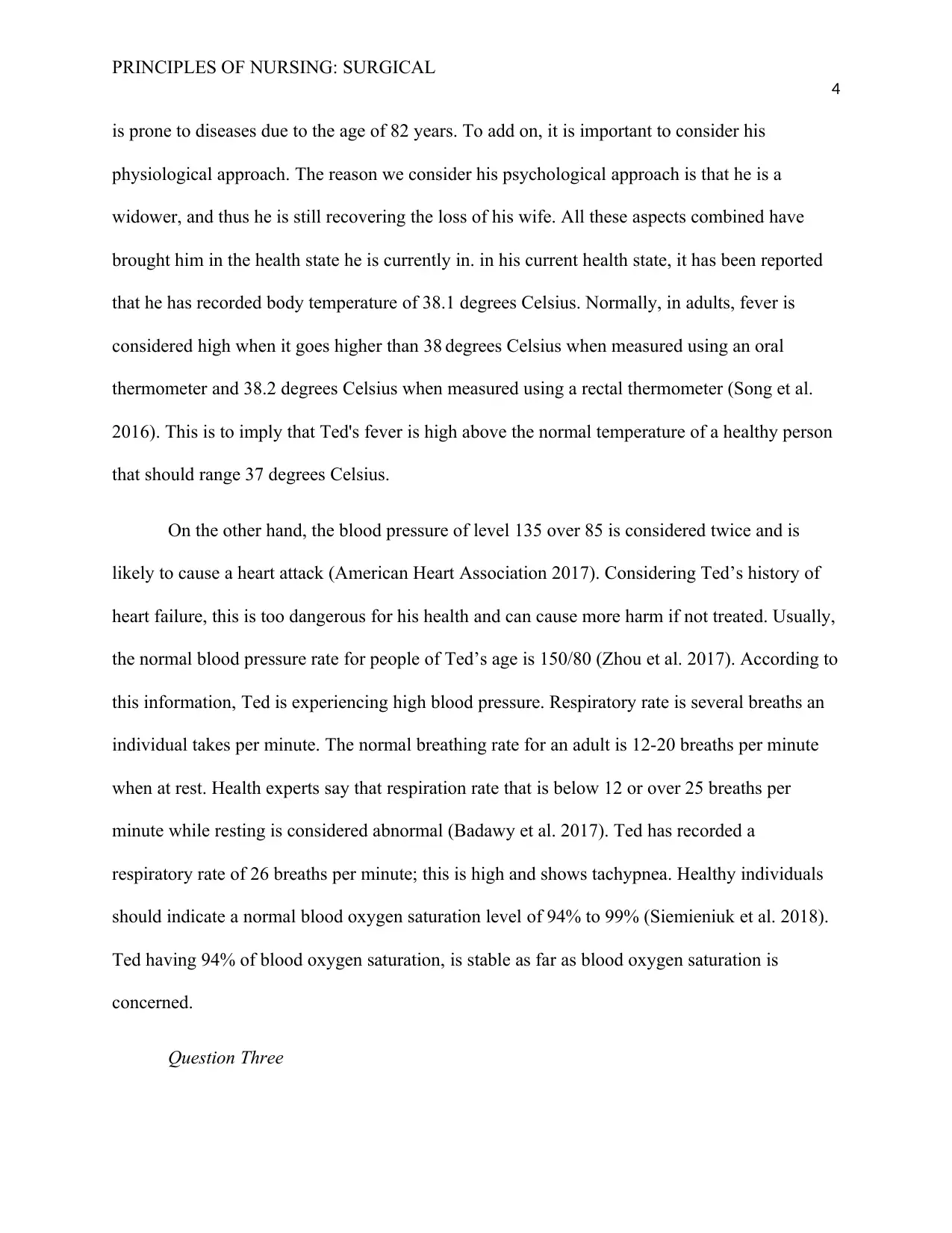
PRINCIPLES OF NURSING: SURGICAL
4
is prone to diseases due to the age of 82 years. To add on, it is important to consider his
physiological approach. The reason we consider his psychological approach is that he is a
widower, and thus he is still recovering the loss of his wife. All these aspects combined have
brought him in the health state he is currently in. in his current health state, it has been reported
that he has recorded body temperature of 38.1 degrees Celsius. Normally, in adults, fever is
considered high when it goes higher than 38 degrees Celsius when measured using an oral
thermometer and 38.2 degrees Celsius when measured using a rectal thermometer (Song et al.
2016). This is to imply that Ted's fever is high above the normal temperature of a healthy person
that should range 37 degrees Celsius.
On the other hand, the blood pressure of level 135 over 85 is considered twice and is
likely to cause a heart attack (American Heart Association 2017). Considering Ted’s history of
heart failure, this is too dangerous for his health and can cause more harm if not treated. Usually,
the normal blood pressure rate for people of Ted’s age is 150/80 (Zhou et al. 2017). According to
this information, Ted is experiencing high blood pressure. Respiratory rate is several breaths an
individual takes per minute. The normal breathing rate for an adult is 12-20 breaths per minute
when at rest. Health experts say that respiration rate that is below 12 or over 25 breaths per
minute while resting is considered abnormal (Badawy et al. 2017). Ted has recorded a
respiratory rate of 26 breaths per minute; this is high and shows tachypnea. Healthy individuals
should indicate a normal blood oxygen saturation level of 94% to 99% (Siemieniuk et al. 2018).
Ted having 94% of blood oxygen saturation, is stable as far as blood oxygen saturation is
concerned.
Question Three
4
is prone to diseases due to the age of 82 years. To add on, it is important to consider his
physiological approach. The reason we consider his psychological approach is that he is a
widower, and thus he is still recovering the loss of his wife. All these aspects combined have
brought him in the health state he is currently in. in his current health state, it has been reported
that he has recorded body temperature of 38.1 degrees Celsius. Normally, in adults, fever is
considered high when it goes higher than 38 degrees Celsius when measured using an oral
thermometer and 38.2 degrees Celsius when measured using a rectal thermometer (Song et al.
2016). This is to imply that Ted's fever is high above the normal temperature of a healthy person
that should range 37 degrees Celsius.
On the other hand, the blood pressure of level 135 over 85 is considered twice and is
likely to cause a heart attack (American Heart Association 2017). Considering Ted’s history of
heart failure, this is too dangerous for his health and can cause more harm if not treated. Usually,
the normal blood pressure rate for people of Ted’s age is 150/80 (Zhou et al. 2017). According to
this information, Ted is experiencing high blood pressure. Respiratory rate is several breaths an
individual takes per minute. The normal breathing rate for an adult is 12-20 breaths per minute
when at rest. Health experts say that respiration rate that is below 12 or over 25 breaths per
minute while resting is considered abnormal (Badawy et al. 2017). Ted has recorded a
respiratory rate of 26 breaths per minute; this is high and shows tachypnea. Healthy individuals
should indicate a normal blood oxygen saturation level of 94% to 99% (Siemieniuk et al. 2018).
Ted having 94% of blood oxygen saturation, is stable as far as blood oxygen saturation is
concerned.
Question Three
Paraphrase This Document
Need a fresh take? Get an instant paraphrase of this document with our AI Paraphraser
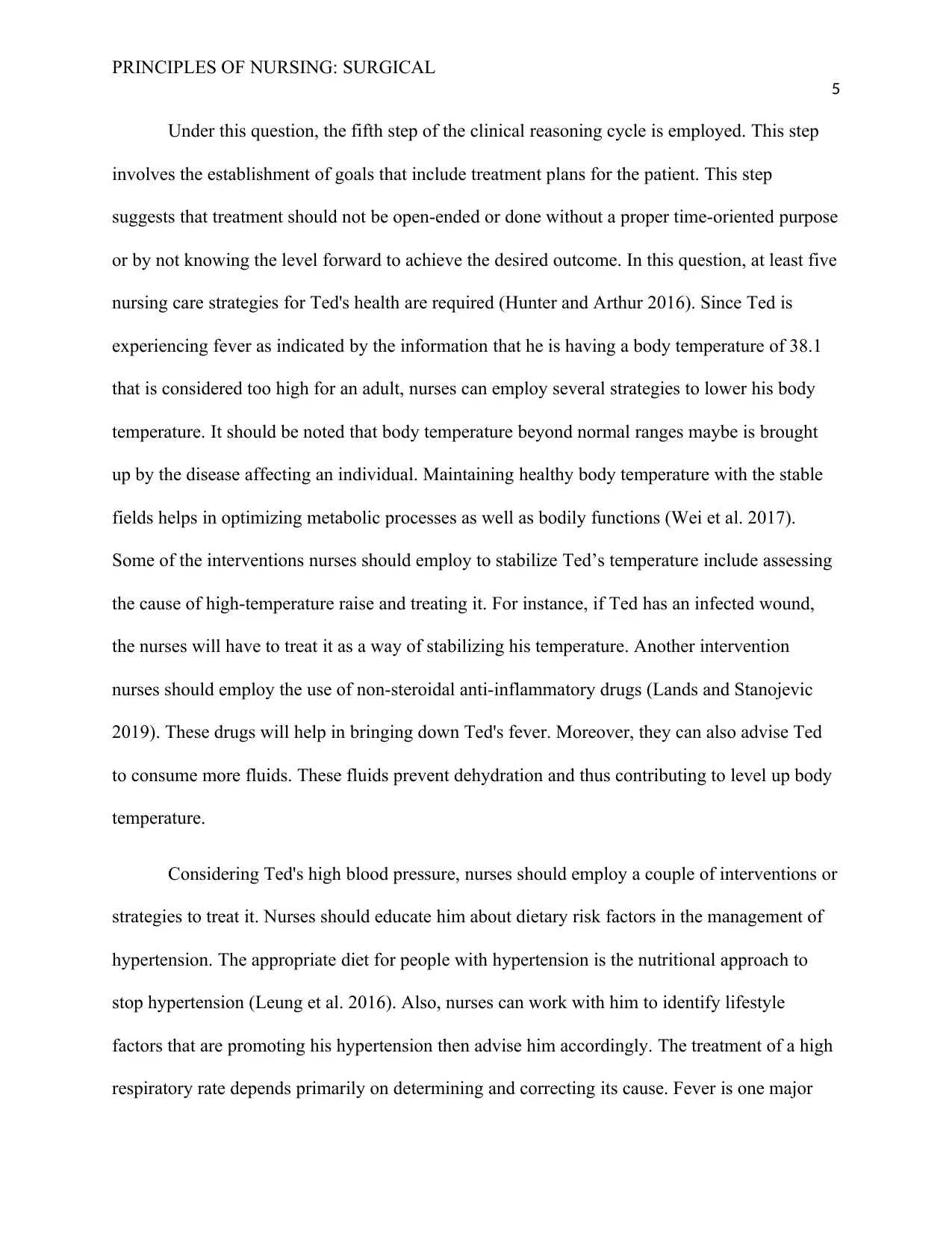
PRINCIPLES OF NURSING: SURGICAL
5
Under this question, the fifth step of the clinical reasoning cycle is employed. This step
involves the establishment of goals that include treatment plans for the patient. This step
suggests that treatment should not be open-ended or done without a proper time-oriented purpose
or by not knowing the level forward to achieve the desired outcome. In this question, at least five
nursing care strategies for Ted's health are required (Hunter and Arthur 2016). Since Ted is
experiencing fever as indicated by the information that he is having a body temperature of 38.1
that is considered too high for an adult, nurses can employ several strategies to lower his body
temperature. It should be noted that body temperature beyond normal ranges maybe is brought
up by the disease affecting an individual. Maintaining healthy body temperature with the stable
fields helps in optimizing metabolic processes as well as bodily functions (Wei et al. 2017).
Some of the interventions nurses should employ to stabilize Ted’s temperature include assessing
the cause of high-temperature raise and treating it. For instance, if Ted has an infected wound,
the nurses will have to treat it as a way of stabilizing his temperature. Another intervention
nurses should employ the use of non-steroidal anti-inflammatory drugs (Lands and Stanojevic
2019). These drugs will help in bringing down Ted's fever. Moreover, they can also advise Ted
to consume more fluids. These fluids prevent dehydration and thus contributing to level up body
temperature.
Considering Ted's high blood pressure, nurses should employ a couple of interventions or
strategies to treat it. Nurses should educate him about dietary risk factors in the management of
hypertension. The appropriate diet for people with hypertension is the nutritional approach to
stop hypertension (Leung et al. 2016). Also, nurses can work with him to identify lifestyle
factors that are promoting his hypertension then advise him accordingly. The treatment of a high
respiratory rate depends primarily on determining and correcting its cause. Fever is one major
5
Under this question, the fifth step of the clinical reasoning cycle is employed. This step
involves the establishment of goals that include treatment plans for the patient. This step
suggests that treatment should not be open-ended or done without a proper time-oriented purpose
or by not knowing the level forward to achieve the desired outcome. In this question, at least five
nursing care strategies for Ted's health are required (Hunter and Arthur 2016). Since Ted is
experiencing fever as indicated by the information that he is having a body temperature of 38.1
that is considered too high for an adult, nurses can employ several strategies to lower his body
temperature. It should be noted that body temperature beyond normal ranges maybe is brought
up by the disease affecting an individual. Maintaining healthy body temperature with the stable
fields helps in optimizing metabolic processes as well as bodily functions (Wei et al. 2017).
Some of the interventions nurses should employ to stabilize Ted’s temperature include assessing
the cause of high-temperature raise and treating it. For instance, if Ted has an infected wound,
the nurses will have to treat it as a way of stabilizing his temperature. Another intervention
nurses should employ the use of non-steroidal anti-inflammatory drugs (Lands and Stanojevic
2019). These drugs will help in bringing down Ted's fever. Moreover, they can also advise Ted
to consume more fluids. These fluids prevent dehydration and thus contributing to level up body
temperature.
Considering Ted's high blood pressure, nurses should employ a couple of interventions or
strategies to treat it. Nurses should educate him about dietary risk factors in the management of
hypertension. The appropriate diet for people with hypertension is the nutritional approach to
stop hypertension (Leung et al. 2016). Also, nurses can work with him to identify lifestyle
factors that are promoting his hypertension then advise him accordingly. The treatment of a high
respiratory rate depends primarily on determining and correcting its cause. Fever is one major
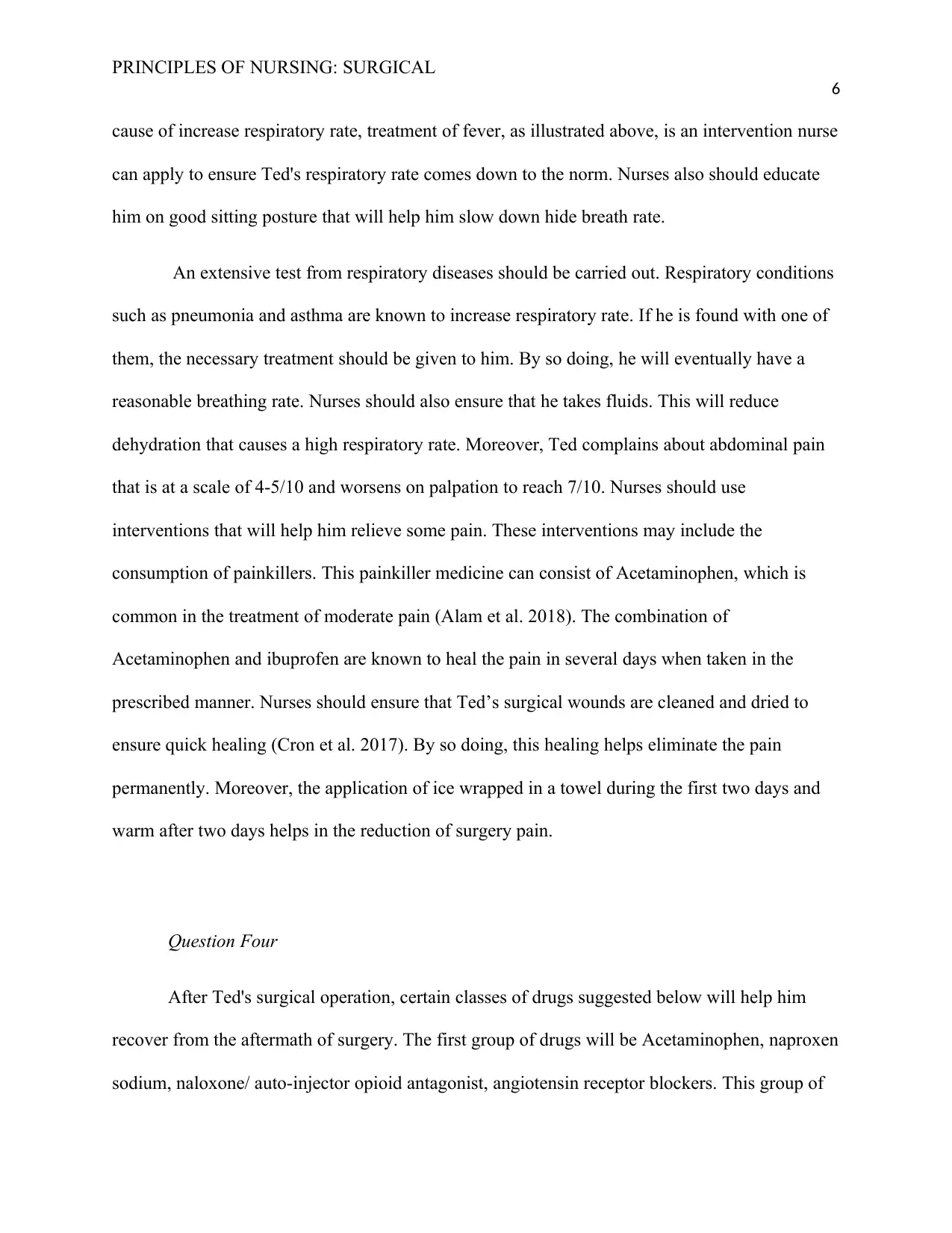
PRINCIPLES OF NURSING: SURGICAL
6
cause of increase respiratory rate, treatment of fever, as illustrated above, is an intervention nurse
can apply to ensure Ted's respiratory rate comes down to the norm. Nurses also should educate
him on good sitting posture that will help him slow down hide breath rate.
An extensive test from respiratory diseases should be carried out. Respiratory conditions
such as pneumonia and asthma are known to increase respiratory rate. If he is found with one of
them, the necessary treatment should be given to him. By so doing, he will eventually have a
reasonable breathing rate. Nurses should also ensure that he takes fluids. This will reduce
dehydration that causes a high respiratory rate. Moreover, Ted complains about abdominal pain
that is at a scale of 4-5/10 and worsens on palpation to reach 7/10. Nurses should use
interventions that will help him relieve some pain. These interventions may include the
consumption of painkillers. This painkiller medicine can consist of Acetaminophen, which is
common in the treatment of moderate pain (Alam et al. 2018). The combination of
Acetaminophen and ibuprofen are known to heal the pain in several days when taken in the
prescribed manner. Nurses should ensure that Ted’s surgical wounds are cleaned and dried to
ensure quick healing (Cron et al. 2017). By so doing, this healing helps eliminate the pain
permanently. Moreover, the application of ice wrapped in a towel during the first two days and
warm after two days helps in the reduction of surgery pain.
Question Four
After Ted's surgical operation, certain classes of drugs suggested below will help him
recover from the aftermath of surgery. The first group of drugs will be Acetaminophen, naproxen
sodium, naloxone/ auto-injector opioid antagonist, angiotensin receptor blockers. This group of
6
cause of increase respiratory rate, treatment of fever, as illustrated above, is an intervention nurse
can apply to ensure Ted's respiratory rate comes down to the norm. Nurses also should educate
him on good sitting posture that will help him slow down hide breath rate.
An extensive test from respiratory diseases should be carried out. Respiratory conditions
such as pneumonia and asthma are known to increase respiratory rate. If he is found with one of
them, the necessary treatment should be given to him. By so doing, he will eventually have a
reasonable breathing rate. Nurses should also ensure that he takes fluids. This will reduce
dehydration that causes a high respiratory rate. Moreover, Ted complains about abdominal pain
that is at a scale of 4-5/10 and worsens on palpation to reach 7/10. Nurses should use
interventions that will help him relieve some pain. These interventions may include the
consumption of painkillers. This painkiller medicine can consist of Acetaminophen, which is
common in the treatment of moderate pain (Alam et al. 2018). The combination of
Acetaminophen and ibuprofen are known to heal the pain in several days when taken in the
prescribed manner. Nurses should ensure that Ted’s surgical wounds are cleaned and dried to
ensure quick healing (Cron et al. 2017). By so doing, this healing helps eliminate the pain
permanently. Moreover, the application of ice wrapped in a towel during the first two days and
warm after two days helps in the reduction of surgery pain.
Question Four
After Ted's surgical operation, certain classes of drugs suggested below will help him
recover from the aftermath of surgery. The first group of drugs will be Acetaminophen, naproxen
sodium, naloxone/ auto-injector opioid antagonist, angiotensin receptor blockers. This group of
⊘ This is a preview!⊘
Do you want full access?
Subscribe today to unlock all pages.

Trusted by 1+ million students worldwide
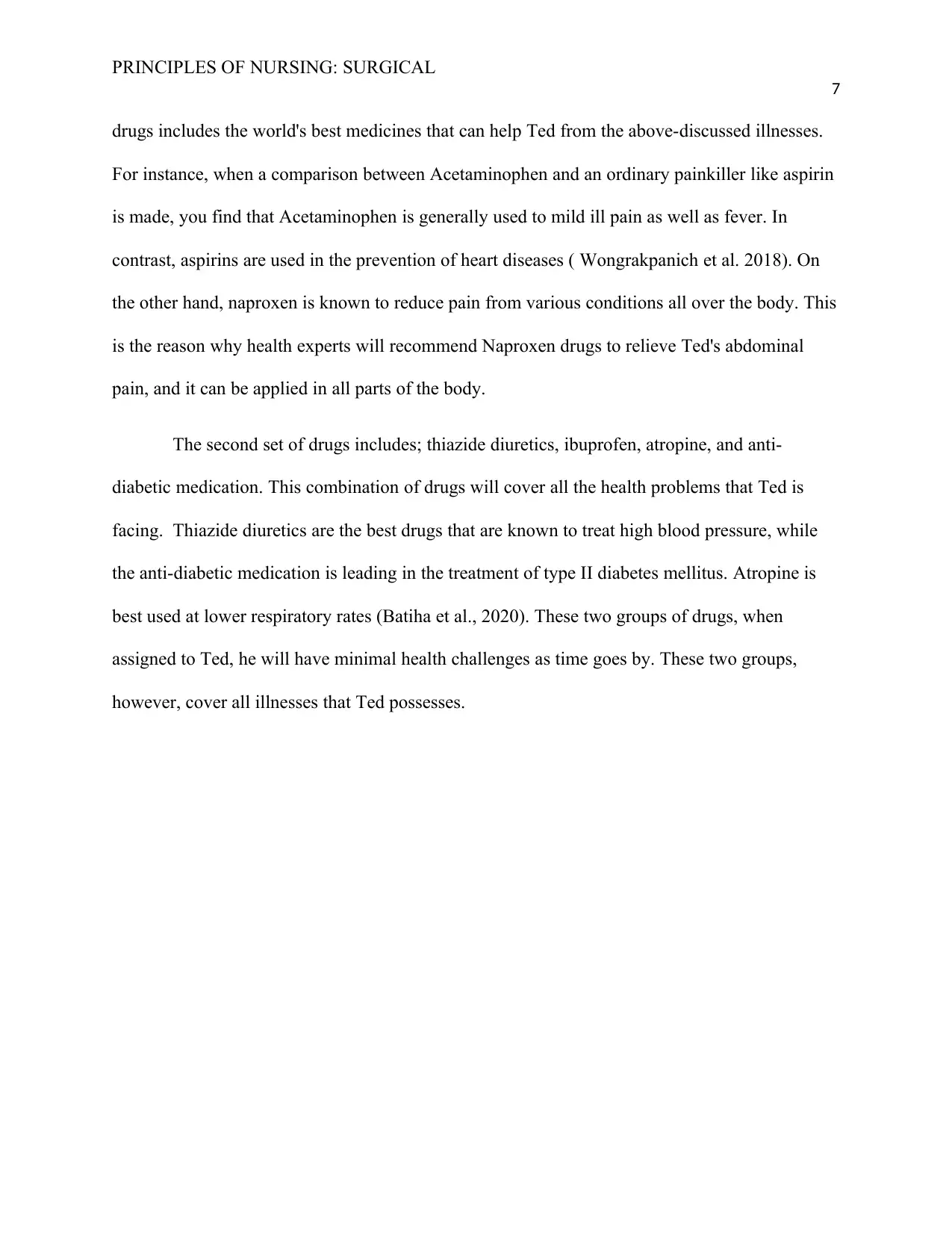
PRINCIPLES OF NURSING: SURGICAL
7
drugs includes the world's best medicines that can help Ted from the above-discussed illnesses.
For instance, when a comparison between Acetaminophen and an ordinary painkiller like aspirin
is made, you find that Acetaminophen is generally used to mild ill pain as well as fever. In
contrast, aspirins are used in the prevention of heart diseases ( Wongrakpanich et al. 2018). On
the other hand, naproxen is known to reduce pain from various conditions all over the body. This
is the reason why health experts will recommend Naproxen drugs to relieve Ted's abdominal
pain, and it can be applied in all parts of the body.
The second set of drugs includes; thiazide diuretics, ibuprofen, atropine, and anti-
diabetic medication. This combination of drugs will cover all the health problems that Ted is
facing. Thiazide diuretics are the best drugs that are known to treat high blood pressure, while
the anti-diabetic medication is leading in the treatment of type II diabetes mellitus. Atropine is
best used at lower respiratory rates (Batiha et al., 2020). These two groups of drugs, when
assigned to Ted, he will have minimal health challenges as time goes by. These two groups,
however, cover all illnesses that Ted possesses.
7
drugs includes the world's best medicines that can help Ted from the above-discussed illnesses.
For instance, when a comparison between Acetaminophen and an ordinary painkiller like aspirin
is made, you find that Acetaminophen is generally used to mild ill pain as well as fever. In
contrast, aspirins are used in the prevention of heart diseases ( Wongrakpanich et al. 2018). On
the other hand, naproxen is known to reduce pain from various conditions all over the body. This
is the reason why health experts will recommend Naproxen drugs to relieve Ted's abdominal
pain, and it can be applied in all parts of the body.
The second set of drugs includes; thiazide diuretics, ibuprofen, atropine, and anti-
diabetic medication. This combination of drugs will cover all the health problems that Ted is
facing. Thiazide diuretics are the best drugs that are known to treat high blood pressure, while
the anti-diabetic medication is leading in the treatment of type II diabetes mellitus. Atropine is
best used at lower respiratory rates (Batiha et al., 2020). These two groups of drugs, when
assigned to Ted, he will have minimal health challenges as time goes by. These two groups,
however, cover all illnesses that Ted possesses.
Paraphrase This Document
Need a fresh take? Get an instant paraphrase of this document with our AI Paraphraser
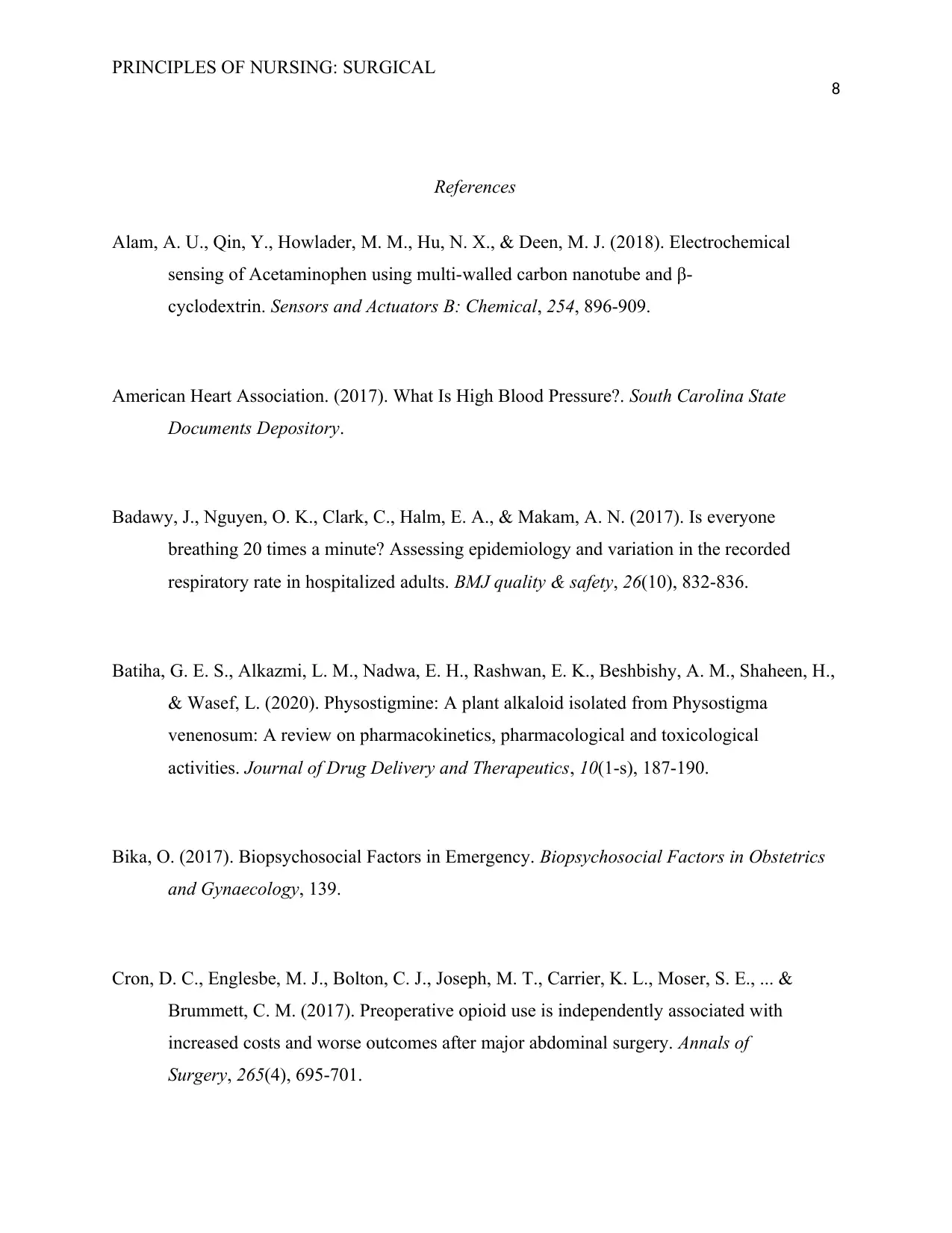
PRINCIPLES OF NURSING: SURGICAL
8
References
Alam, A. U., Qin, Y., Howlader, M. M., Hu, N. X., & Deen, M. J. (2018). Electrochemical
sensing of Acetaminophen using multi-walled carbon nanotube and β-
cyclodextrin. Sensors and Actuators B: Chemical, 254, 896-909.
American Heart Association. (2017). What Is High Blood Pressure?. South Carolina State
Documents Depository.
Badawy, J., Nguyen, O. K., Clark, C., Halm, E. A., & Makam, A. N. (2017). Is everyone
breathing 20 times a minute? Assessing epidemiology and variation in the recorded
respiratory rate in hospitalized adults. BMJ quality & safety, 26(10), 832-836.
Batiha, G. E. S., Alkazmi, L. M., Nadwa, E. H., Rashwan, E. K., Beshbishy, A. M., Shaheen, H.,
& Wasef, L. (2020). Physostigmine: A plant alkaloid isolated from Physostigma
venenosum: A review on pharmacokinetics, pharmacological and toxicological
activities. Journal of Drug Delivery and Therapeutics, 10(1-s), 187-190.
Bika, O. (2017). Biopsychosocial Factors in Emergency. Biopsychosocial Factors in Obstetrics
and Gynaecology, 139.
Cron, D. C., Englesbe, M. J., Bolton, C. J., Joseph, M. T., Carrier, K. L., Moser, S. E., ... &
Brummett, C. M. (2017). Preoperative opioid use is independently associated with
increased costs and worse outcomes after major abdominal surgery. Annals of
Surgery, 265(4), 695-701.
8
References
Alam, A. U., Qin, Y., Howlader, M. M., Hu, N. X., & Deen, M. J. (2018). Electrochemical
sensing of Acetaminophen using multi-walled carbon nanotube and β-
cyclodextrin. Sensors and Actuators B: Chemical, 254, 896-909.
American Heart Association. (2017). What Is High Blood Pressure?. South Carolina State
Documents Depository.
Badawy, J., Nguyen, O. K., Clark, C., Halm, E. A., & Makam, A. N. (2017). Is everyone
breathing 20 times a minute? Assessing epidemiology and variation in the recorded
respiratory rate in hospitalized adults. BMJ quality & safety, 26(10), 832-836.
Batiha, G. E. S., Alkazmi, L. M., Nadwa, E. H., Rashwan, E. K., Beshbishy, A. M., Shaheen, H.,
& Wasef, L. (2020). Physostigmine: A plant alkaloid isolated from Physostigma
venenosum: A review on pharmacokinetics, pharmacological and toxicological
activities. Journal of Drug Delivery and Therapeutics, 10(1-s), 187-190.
Bika, O. (2017). Biopsychosocial Factors in Emergency. Biopsychosocial Factors in Obstetrics
and Gynaecology, 139.
Cron, D. C., Englesbe, M. J., Bolton, C. J., Joseph, M. T., Carrier, K. L., Moser, S. E., ... &
Brummett, C. M. (2017). Preoperative opioid use is independently associated with
increased costs and worse outcomes after major abdominal surgery. Annals of
Surgery, 265(4), 695-701.
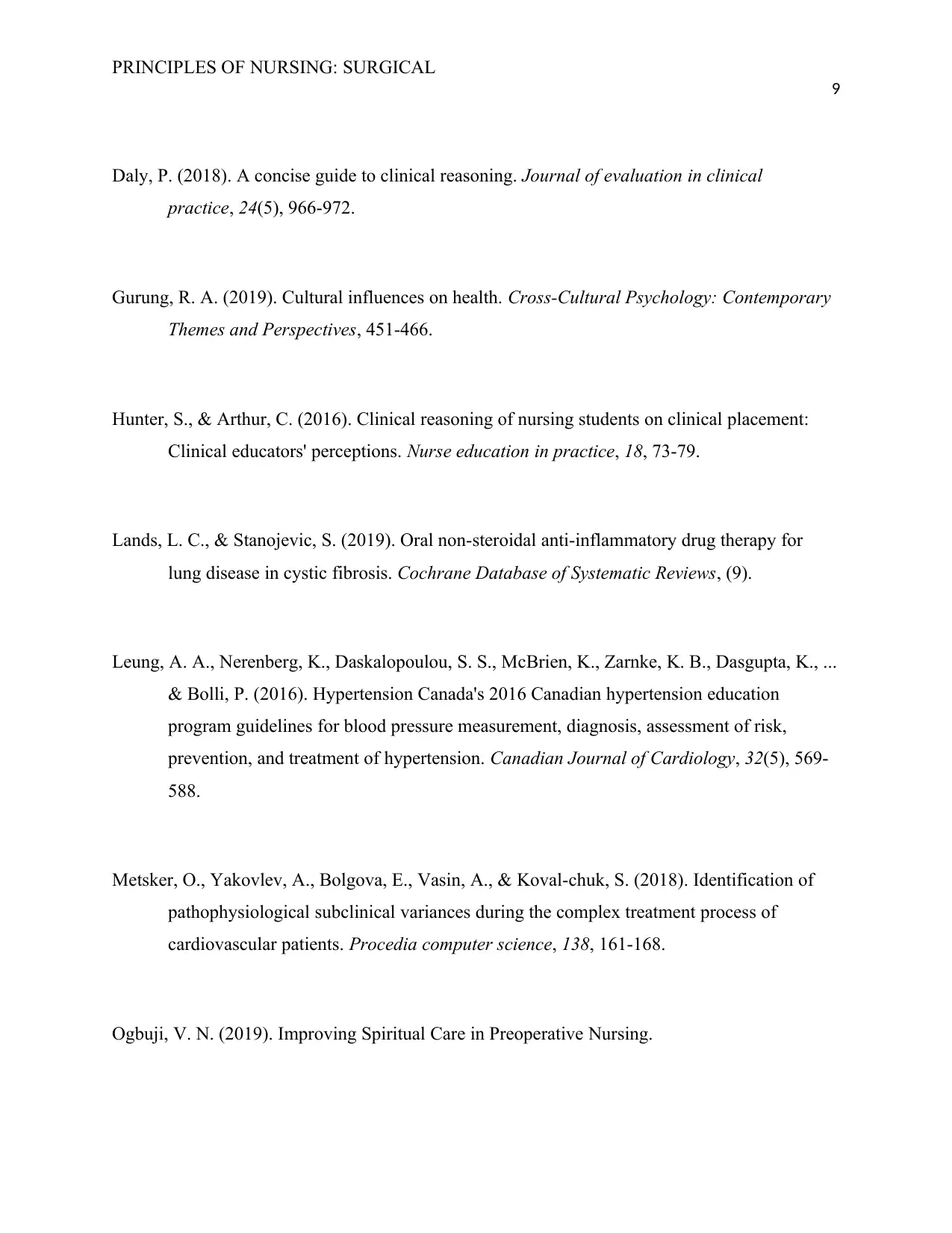
PRINCIPLES OF NURSING: SURGICAL
9
Daly, P. (2018). A concise guide to clinical reasoning. Journal of evaluation in clinical
practice, 24(5), 966-972.
Gurung, R. A. (2019). Cultural influences on health. Cross‐Cultural Psychology: Contemporary
Themes and Perspectives, 451-466.
Hunter, S., & Arthur, C. (2016). Clinical reasoning of nursing students on clinical placement:
Clinical educators' perceptions. Nurse education in practice, 18, 73-79.
Lands, L. C., & Stanojevic, S. (2019). Oral non‐steroidal anti‐inflammatory drug therapy for
lung disease in cystic fibrosis. Cochrane Database of Systematic Reviews, (9).
Leung, A. A., Nerenberg, K., Daskalopoulou, S. S., McBrien, K., Zarnke, K. B., Dasgupta, K., ...
& Bolli, P. (2016). Hypertension Canada's 2016 Canadian hypertension education
program guidelines for blood pressure measurement, diagnosis, assessment of risk,
prevention, and treatment of hypertension. Canadian Journal of Cardiology, 32(5), 569-
588.
Metsker, O., Yakovlev, A., Bolgova, E., Vasin, A., & Koval-chuk, S. (2018). Identification of
pathophysiological subclinical variances during the complex treatment process of
cardiovascular patients. Procedia computer science, 138, 161-168.
Ogbuji, V. N. (2019). Improving Spiritual Care in Preoperative Nursing.
9
Daly, P. (2018). A concise guide to clinical reasoning. Journal of evaluation in clinical
practice, 24(5), 966-972.
Gurung, R. A. (2019). Cultural influences on health. Cross‐Cultural Psychology: Contemporary
Themes and Perspectives, 451-466.
Hunter, S., & Arthur, C. (2016). Clinical reasoning of nursing students on clinical placement:
Clinical educators' perceptions. Nurse education in practice, 18, 73-79.
Lands, L. C., & Stanojevic, S. (2019). Oral non‐steroidal anti‐inflammatory drug therapy for
lung disease in cystic fibrosis. Cochrane Database of Systematic Reviews, (9).
Leung, A. A., Nerenberg, K., Daskalopoulou, S. S., McBrien, K., Zarnke, K. B., Dasgupta, K., ...
& Bolli, P. (2016). Hypertension Canada's 2016 Canadian hypertension education
program guidelines for blood pressure measurement, diagnosis, assessment of risk,
prevention, and treatment of hypertension. Canadian Journal of Cardiology, 32(5), 569-
588.
Metsker, O., Yakovlev, A., Bolgova, E., Vasin, A., & Koval-chuk, S. (2018). Identification of
pathophysiological subclinical variances during the complex treatment process of
cardiovascular patients. Procedia computer science, 138, 161-168.
Ogbuji, V. N. (2019). Improving Spiritual Care in Preoperative Nursing.
⊘ This is a preview!⊘
Do you want full access?
Subscribe today to unlock all pages.

Trusted by 1+ million students worldwide
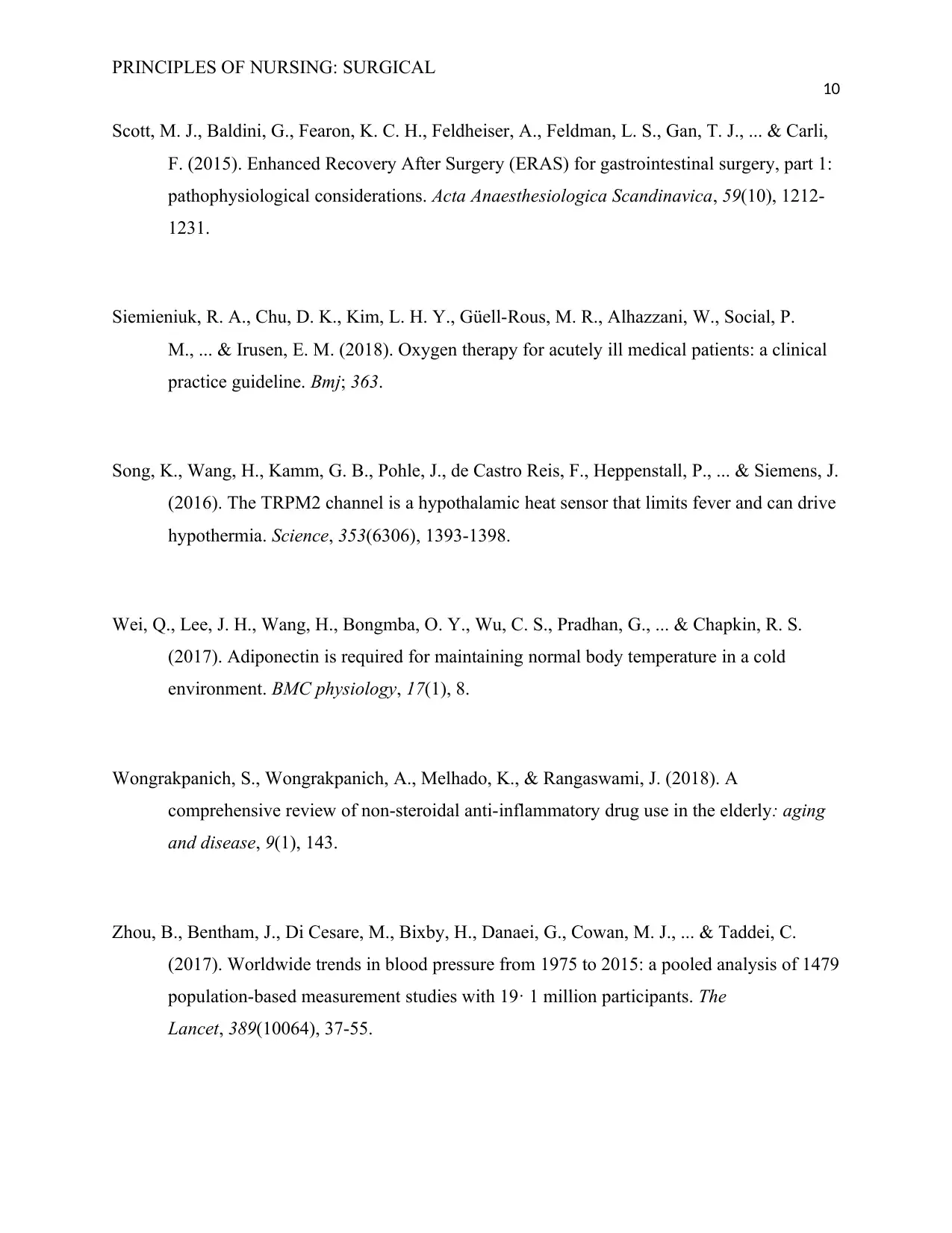
PRINCIPLES OF NURSING: SURGICAL
10
Scott, M. J., Baldini, G., Fearon, K. C. H., Feldheiser, A., Feldman, L. S., Gan, T. J., ... & Carli,
F. (2015). Enhanced Recovery After Surgery (ERAS) for gastrointestinal surgery, part 1:
pathophysiological considerations. Acta Anaesthesiologica Scandinavica, 59(10), 1212-
1231.
Siemieniuk, R. A., Chu, D. K., Kim, L. H. Y., Güell-Rous, M. R., Alhazzani, W., Social, P.
M., ... & Irusen, E. M. (2018). Oxygen therapy for acutely ill medical patients: a clinical
practice guideline. Bmj; 363.
Song, K., Wang, H., Kamm, G. B., Pohle, J., de Castro Reis, F., Heppenstall, P., ... & Siemens, J.
(2016). The TRPM2 channel is a hypothalamic heat sensor that limits fever and can drive
hypothermia. Science, 353(6306), 1393-1398.
Wei, Q., Lee, J. H., Wang, H., Bongmba, O. Y., Wu, C. S., Pradhan, G., ... & Chapkin, R. S.
(2017). Adiponectin is required for maintaining normal body temperature in a cold
environment. BMC physiology, 17(1), 8.
Wongrakpanich, S., Wongrakpanich, A., Melhado, K., & Rangaswami, J. (2018). A
comprehensive review of non-steroidal anti-inflammatory drug use in the elderly: aging
and disease, 9(1), 143.
Zhou, B., Bentham, J., Di Cesare, M., Bixby, H., Danaei, G., Cowan, M. J., ... & Taddei, C.
(2017). Worldwide trends in blood pressure from 1975 to 2015: a pooled analysis of 1479
population-based measurement studies with 19· 1 million participants. The
Lancet, 389(10064), 37-55.
10
Scott, M. J., Baldini, G., Fearon, K. C. H., Feldheiser, A., Feldman, L. S., Gan, T. J., ... & Carli,
F. (2015). Enhanced Recovery After Surgery (ERAS) for gastrointestinal surgery, part 1:
pathophysiological considerations. Acta Anaesthesiologica Scandinavica, 59(10), 1212-
1231.
Siemieniuk, R. A., Chu, D. K., Kim, L. H. Y., Güell-Rous, M. R., Alhazzani, W., Social, P.
M., ... & Irusen, E. M. (2018). Oxygen therapy for acutely ill medical patients: a clinical
practice guideline. Bmj; 363.
Song, K., Wang, H., Kamm, G. B., Pohle, J., de Castro Reis, F., Heppenstall, P., ... & Siemens, J.
(2016). The TRPM2 channel is a hypothalamic heat sensor that limits fever and can drive
hypothermia. Science, 353(6306), 1393-1398.
Wei, Q., Lee, J. H., Wang, H., Bongmba, O. Y., Wu, C. S., Pradhan, G., ... & Chapkin, R. S.
(2017). Adiponectin is required for maintaining normal body temperature in a cold
environment. BMC physiology, 17(1), 8.
Wongrakpanich, S., Wongrakpanich, A., Melhado, K., & Rangaswami, J. (2018). A
comprehensive review of non-steroidal anti-inflammatory drug use in the elderly: aging
and disease, 9(1), 143.
Zhou, B., Bentham, J., Di Cesare, M., Bixby, H., Danaei, G., Cowan, M. J., ... & Taddei, C.
(2017). Worldwide trends in blood pressure from 1975 to 2015: a pooled analysis of 1479
population-based measurement studies with 19· 1 million participants. The
Lancet, 389(10064), 37-55.
1 out of 10
Related Documents
Your All-in-One AI-Powered Toolkit for Academic Success.
+13062052269
info@desklib.com
Available 24*7 on WhatsApp / Email
![[object Object]](/_next/static/media/star-bottom.7253800d.svg)
Unlock your academic potential
Copyright © 2020–2025 A2Z Services. All Rights Reserved. Developed and managed by ZUCOL.





